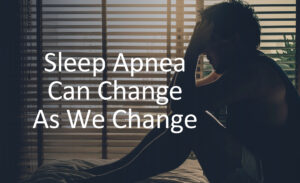Obstructive sleep apnea is a growing problem in America, especially as we grow and age. For those that have tested positive for sleep apnea, the apnea can change over time and will need retesting. For those that have tested negative, sleep apnea may develop later in life.

There are many contributing factors to sleep apnea:
- Weight
- Anatomical structure
- Enlarged tonsils and adenoids
- Pulmonary disease
- Respiratory inflammation and congestion
- Altitude
- Neurological disorders or damage
- Muscular degeneration
- Age
… to name a few.
An apnea occurs when airway collapses during sleep cause a cessation in breathing. Studies have show that increase tissue around airway can contribute to airway collapse. The tissue could be anatomical like enlarged tonsils, scalloped tongue, or fatty tissue deposits in the neck from obesity. Therefore, obstructive sleep apnea (OSA) is closely tied to obesity.
Pulmonary disease like COPD and asthma is also associated with a higher risk of sleep apnea, and
More commonly, sleep apnea occurs because the muscles around the airway that work to keep the airway open atrophy and weaken as we age. The reduced muscle tone means even at normal weight and respiratory function, airways can collapse. Some studies show 44% of people over 65 have sleep apnea.
With all of these contributing factors, the risk of sleep apnea and the severity of sleep apnea are likely to change over time. That means that testing will need to be repeated and treatment will need to be adjusted. The American Academy of Sleep Medicine released guidance on how often a sleep test should be repeated.
Of course, there is no magic number for how long before testing again or adjusting treatment. The insurance companies say 5 years, meaning they will require you to retest after 5 year in order for them to pay for new or replacement treatment.
The reality is that if any of the factors listed above change, your apnea could change. So, if you lose or gain wait, develop a breathing condition or allergies, or move to a new location, you should be tested. And even if none of them have changed, just the effects of aging could be enough to develop apnea.
Those already on therapy for sleep apnea may need to have it adjusted. The pressure level of a CPAP may need to be increased with aging. The setting of an oral appliance may need to be adjusted as weight or anatomy changes. And any changes need to be evaluated for improved efficacy with a sleep test.
The good news is that technology in sleep testing continues to advance. Sleep Apnea can be safely and easily diagnosed or evaluated in the comfort of home with a Home Sleep Test (HST) from a company such as Millennium.
